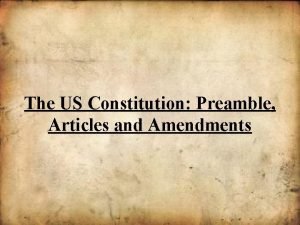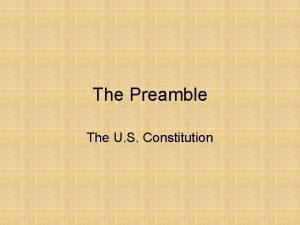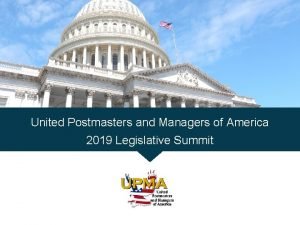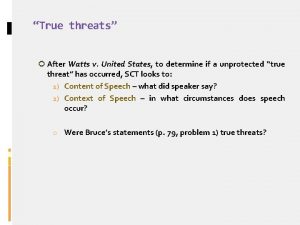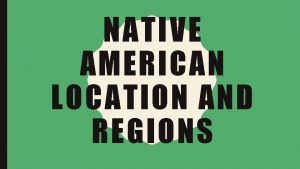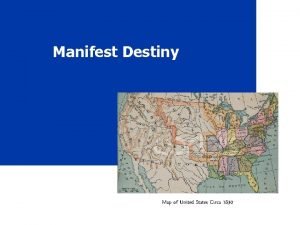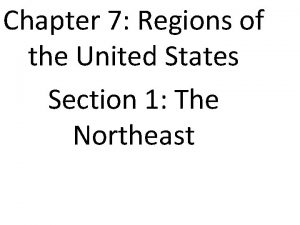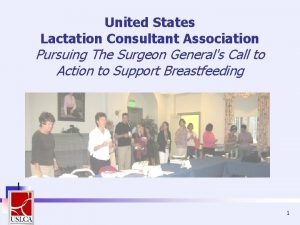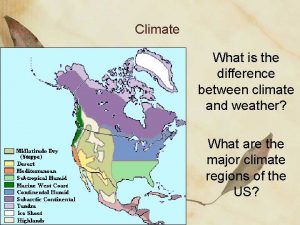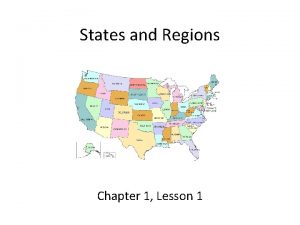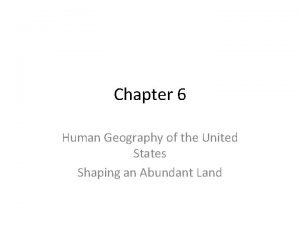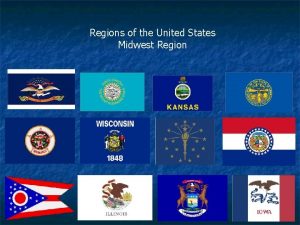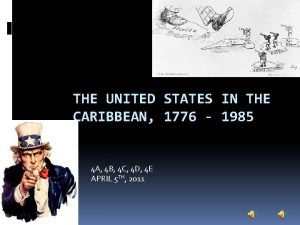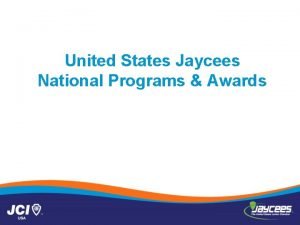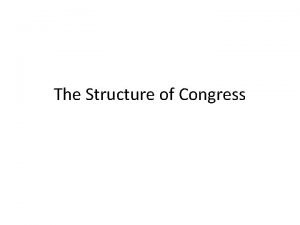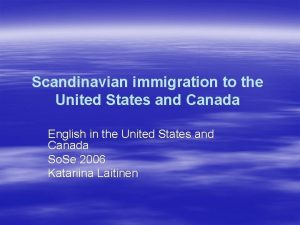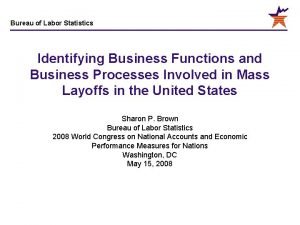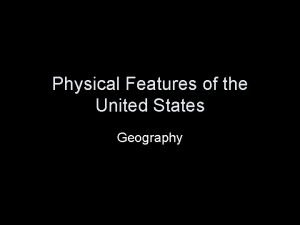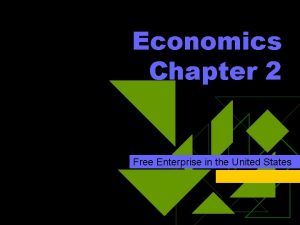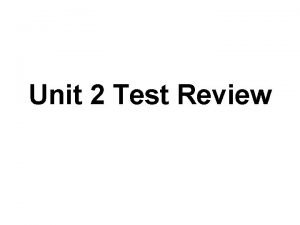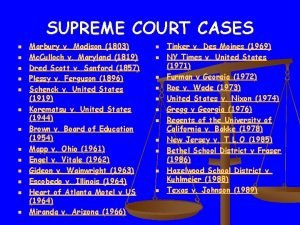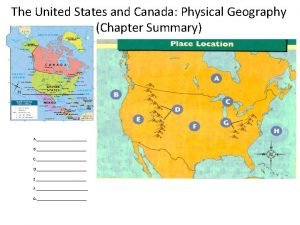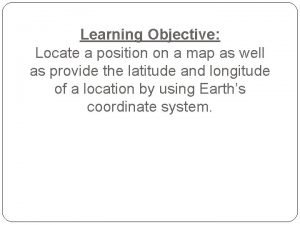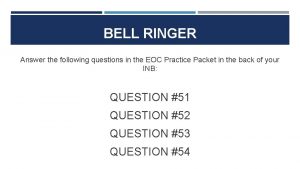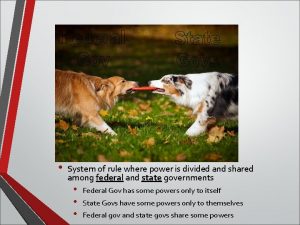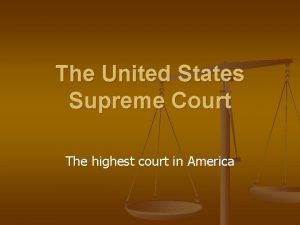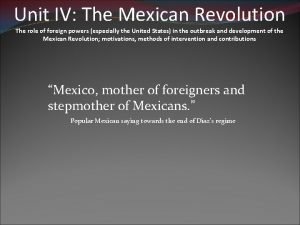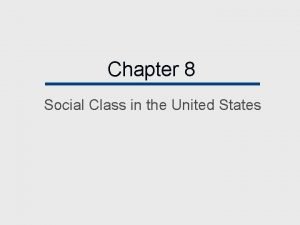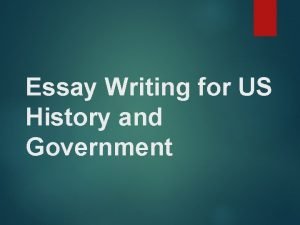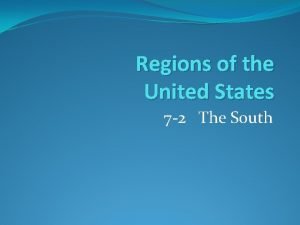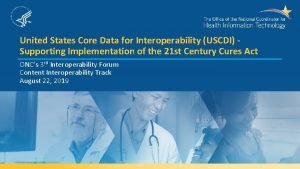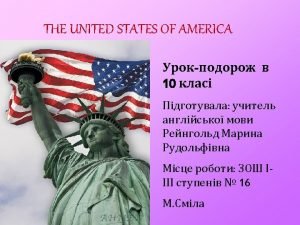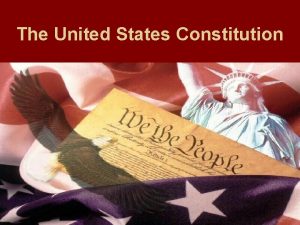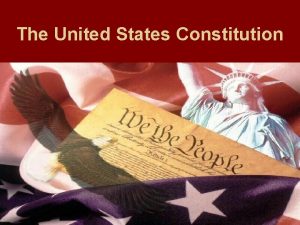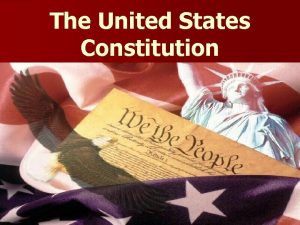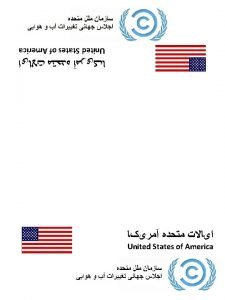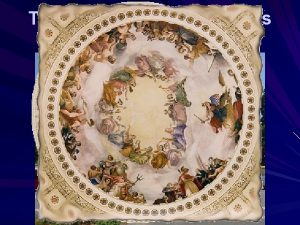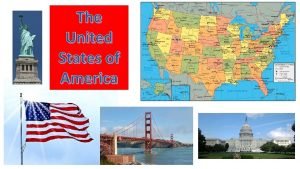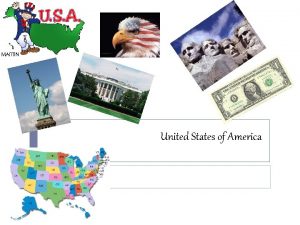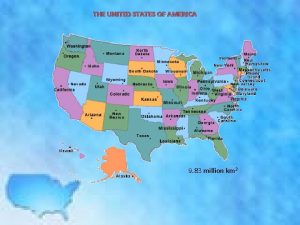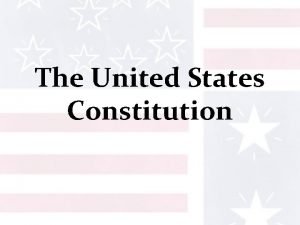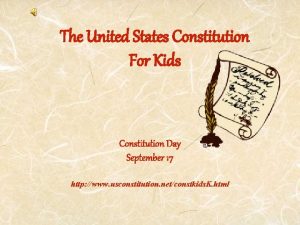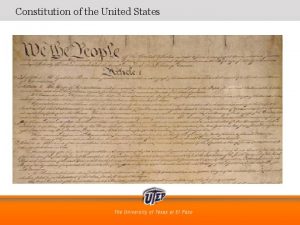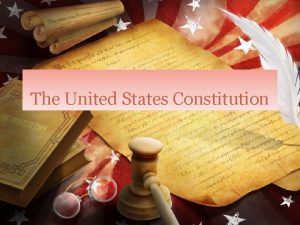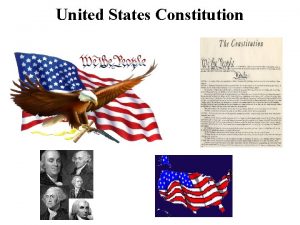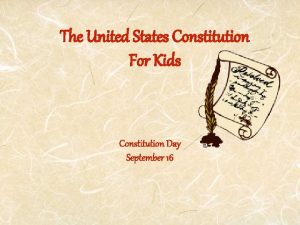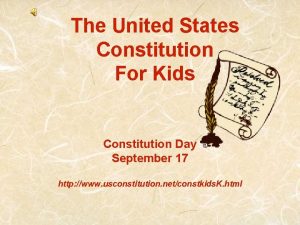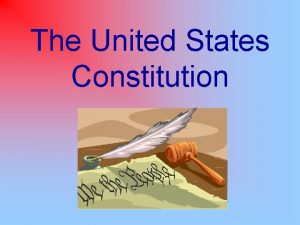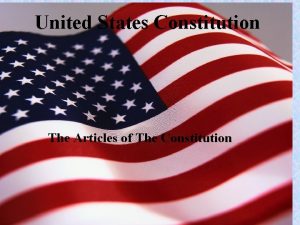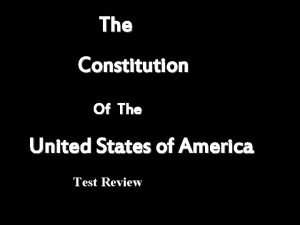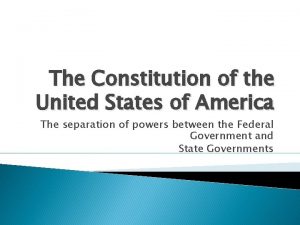The Constitution of the United States of America



















































- Slides: 51

The Constitution of the United States of America

AIM: What is the structure of the national government? Objective: SWBAT analyze the constitution. Do Now: Explain: why the Articles of Confederation failed? Did the framers of the constitution use the failures of the Articles of Confederation to create a new charter?

Why Does the Constitution Matter? Constitution – body of fundamental laws which say how a government is to operate n It is the supreme law of the land n It explains how the government works n It protects your civil rights

Who Wrote It? James Madison is considered “the father of the Constitution. ” His important contributions: n n n The Virginia Plan Separation of Powers Bill of Rights

Why was it written? After the Revolutionary War, the Articles of Confederation set up the structure of the US Government. The federal government was extremely weak and this created many problems such as: 1. 2. 3. No separation of powers – only unicameral legislature. Weak central government – states had most power. Congress did not have the power to tax – this means they could not get their finances in order.

Why was it written? More problems with the Articles of Confederation: 4. 5. 6. In order to change the Articles, all thirteen states had to approve of the changes. This made it essentially impossible to make any changes. For any major laws to pass they had to be approved by 9 or the 13 states which was difficult. Congress did not have the power to regulate commerce which caused competition between states. It also caused diplomatic issues when states refused to pay for goods their received from other nations.

Why was it written? Shays’ Rebellion: n n An uprising of farmers in Massachusetts – led by Daniel Shays. Helped convince leaders that a strong central government was needed. "A scene at Springfield, during Shay's Rebellion, when the mob attempted to prevent the holding of the Courts of Justice. "—E. Benjamin Andrews, 1895

When was it written? May 25 th to September 17 th, 1787 Philadelphia Intention was to revise Articles of Confederation Ended up replacing the Articles and creating a new government Called the “Constitutional Convention. ”

What were the important outcomes of the Constitutional Convention • Virginia Plan: – – – Separation of powers Bicameral legislature based on population Federal government had increased powers • New Jersey Plan: – Unicameral legislature where every state received equal representation. Great Compromise: n Hybrid of VA and NJ Plans: Bicameral legislature: n n n House of Reps based on population Senate based upon equal representation Three-Fifth’s Clause: Slaves count as 3/5’s of a person for representation purposes & taxes.

Ratification Debate Needed 9 of 13 states to ratify or official approve of the Constitution before it went into effect. A huge debate emerged between two sides: n n Federalists Anti-Federalists

Federalists v. Anti-Federalists: n n n Supported the Constitution and a strong central government Alexander Hamilton, James Madison, John Jay Federalist Papers – series of articles written in defense of the Constitution Anti-Federalists: n n Supported a weaker central government – felt too much power was taken away from the states Opposed the Constitution Wanted a Bill of Rights included Samuel Adams, Patrick Henry

Ratification Officially adopted after ratified by New Hampshire. Once the new government convened, they added a Bill of Rights to the Constitution.

A Brief Outline The Preamble – lays out the purpose and introduces the Constitution The Articles – the substance of governmental law The Amendments Uncle Sam needs you to study harder!

The Seven Articles I. The Legislative Branch II. The Executive Branch III. The Judicial Branch IV. Relations Among States V. The Amendment Process VI. National Debts, National Supremacy, Oaths of Office VII. Requirements for Ratification

The Six Basic Principles of the Constitution 1. Popular Sovereignty – supreme power rests with and only with the people n Some parts of the Constitution mitigate popular sovereignty Electoral College chooses the president, not popular vote State Legislatures chose the Senate, not popular vote n Later changed to direct popular election by 17 th Amendment

The Six Basic Principles of the Constitution 2. Limited Government n Also called constitutionalism, and rule of law n Government is not all-powerful n Powers government has and doesn’t have are listed

The Six Basic Principles of the Constitution 3. Separation of Powers n U. S. uses a presidential government, where the executive and legislative branches are chosen separately n Each branch has its own powers and responsibilities

The Six Basic Principles of the Constitution 4. Checks and Balances n Each branch is not totally independent of the others

The Six Basic Principles of the Constitution 4. Checks and Balances n They have powers to override each other when necessary


The Six Basic Principles of the Constitution 5. Judicial Review n Courts may determine whether or not what the President or Congress does is Constitutional

The Six Basic Principles of the Constitution 5. Judicial Review n If court declares an act unconstitutional, the act is not a law, and the decision cannot be overridden

The Six Basic Principles of the Constitution 6. Federalism n The national government is given certain powers by the Constitution n Whatever is left is a power for the states to use

Key Parts of Article I Section 8 n List of all expressed powers Congress has n Also includes the “necessary and proper” clause Gives Congress additional “implied powers” Section 9 n Prohibits certain actions Congress may take No ex post facto laws – punishment for doing something before it was illegal No suspension of habeas corpus – the right to challenge one’s own detention in court

Key Parts of Article II Section 2 n President can appoint people to many positions n Must have “advice and consent” of the Senate takes a majority vote to confirm appointments Section 4 n Can only be removed by impeachment for “high crimes and misdemeanors”

Key Parts of Article IV Section 1 – Full Faith and Credit Clause n States must grant each other “full faith and credit” on “public acts, records, and judicial proceedings” Means legal decisions of states must be respected and held to by other states Section 2 – Privileges and Immunities Clause n States must grant residents of other states all “privileges and immunities” they give to their own residents

Article V - Formal Amendment Process Step 1 – Must Be Proposed (happens at the national level) Step 2 – Must Be Ratified (happens at the state level) n This is a reflection of federalism

2 Ways to Propose an Amendment 1. 2/3 vote in both houses of Congress n All 27 Amendments were proposed this way 2. Constitutional Convention requested by 2/3 of the states n Has not ever been used

2 Ways to Ratify an Amendment 1. 3/4 of state legislatures approve it n 26 of the 27 Amendments were ratified this way 2. 3/4 of conventions called by the states approve it n Only the 21 st Amendment was ratified this way

Key Parts of Article VI Section 2 – Supremacy Clause n Federal laws are always supreme over state laws, U. S. Constitution is supreme over all state constitutions

The First Ten Amendments…

The Bill of Rights These are awesome! And you get to memorize them!

The 1 st Amendment Freedom of Religion Establishment Clause – government cannot establish a religion n Free Exercise Clause – government cannot prohibit you from practicing religion n Freedom of Speech Freedom of the Press Right to Assembly Right to Petition

The 2 nd Amendment The Right to Bear Arms Not the Right to Bare Arms

The 3 rd Amendment No Quartering of Soldiers in Times of Peace

The 4 th Amendment Protection Against Unreasonable Search and Seizure

The 5 th Amendment No Double Jeopardy (Can’t be charged with the same crime twice) Protection against selfincrimination Guarantee of Due Process of Law

The 6 th Amendment Right to a Criminal Trial by Jury n Trial must be speedy, public n Must be in the state where the crime was committed n Right to legal counsel n Right to call witnesses favorable to the defendant

The 7 th Amendment Right to a Civil Trial by Jury n Civil – not criminal, typically a lawsuit for money or to repeal a government action

The 8 th Amendment Protection Against Cruel and Unusual Punishment

The 9 th Amendment Rights Retained by the People n In other words, just because a right isn’t listed here in the Constitution doesn’t mean that people don’t have that right n Truth from your teacher – yes, it does.

The 10 th Amendment Powers Reserved for the States n All powers that are not given to the national government are reserved for the states

Informal Amendments The vast majority of changes to the Constitution have not changed the words in the Constitution

Basic Legislation Congress’ laws provide specific details about the vague purposes and ideas in the Constitution

Basic Legislation Congress also changes its own powers over time, based on the words of the Constitution Result of “Necessary and Proper” Clause

Executive Action Presidents are always looking for ways to stretch and grow their powers Thus, presidents today are much more powerful than in the past

Court Decisions Since Marbury v. Madison, the court has had the power to declare acts of the president and Congress unconstitutional

Court Decisions This power is called judicial review, and the court uses it to tell us what they interpret the Constitution to mean

Party Practices Political parties did not exist at the nation’s start, but they have become an almost necessary element

Party Practices The electoral college used to decide together who would be the president. Now, they just “rubber stamp” the choice of voters

Custom Many customs have developed that we follow just as strongly as laws n Senatorial Courtesy – when nominating a judge, the president always asks the permission of the two Senators from the judge’s state n Cabinet – 15 advisors for the president are not in the Constitution
 The preamble of the constitution
The preamble of the constitution Preamble of american constitution
Preamble of american constitution What is the southeast region of the united states
What is the southeast region of the united states Expansion of the united states of america 1607 to 1853 map
Expansion of the united states of america 1607 to 1853 map Texas constitution vs us constitution
Texas constitution vs us constitution Nc constitution vs us constitution
Nc constitution vs us constitution Constitution what is constitution
Constitution what is constitution The constitution lesson 1 principles of the constitution
The constitution lesson 1 principles of the constitution Upma usps
Upma usps Ap grading review
Ap grading review Awake united states!
Awake united states! Watts vs united states
Watts vs united states Native american tribes in the united states
Native american tribes in the united states Map of us in 1830
Map of us in 1830 What are the 7 regions of the united states?
What are the 7 regions of the united states? Ffa emblem
Ffa emblem United states lactation consultant association
United states lactation consultant association Von thunen's model
Von thunen's model Subtropical united states
Subtropical united states 5 regions of united states
5 regions of united states 36 30 line
36 30 line Chapter 6 human geography of the united states
Chapter 6 human geography of the united states Nnn
Nnn Howland island
Howland island The united states in the caribbean 1776-1985
The united states in the caribbean 1776-1985 United states jaycees
United states jaycees Us land acquisition map
Us land acquisition map What are the two houses of the united states congress?
What are the two houses of the united states congress? How many states canada
How many states canada United states bureau of labor statistics
United states bureau of labor statistics When mr pirzada came to dine themes
When mr pirzada came to dine themes United states physical geography
United states physical geography Chapter 2 free enterprise in the united states answer key
Chapter 2 free enterprise in the united states answer key Geophenom
Geophenom Ep management aiesec
Ep management aiesec Heart of atlanta motel v. united states
Heart of atlanta motel v. united states Define landform
Define landform Melting pot vs salad bowl
Melting pot vs salad bowl Latitude map us
Latitude map us How did these events affect the united states
How did these events affect the united states United states v. lopez commerce clause
United states v. lopez commerce clause Plessy v ferguson summary
Plessy v ferguson summary What the united states has fought for
What the united states has fought for United states soccer league system
United states soccer league system Consequences of social class
Consequences of social class United states bureau of labor statistics
United states bureau of labor statistics Us history regents essay
Us history regents essay States west of the mississippi river
States west of the mississippi river 7 regions of the united states
7 regions of the united states United states core data for interoperability
United states core data for interoperability Contiguous united states land area
Contiguous united states land area Why did truman believe greece needed american aid in 1947?
Why did truman believe greece needed american aid in 1947?
